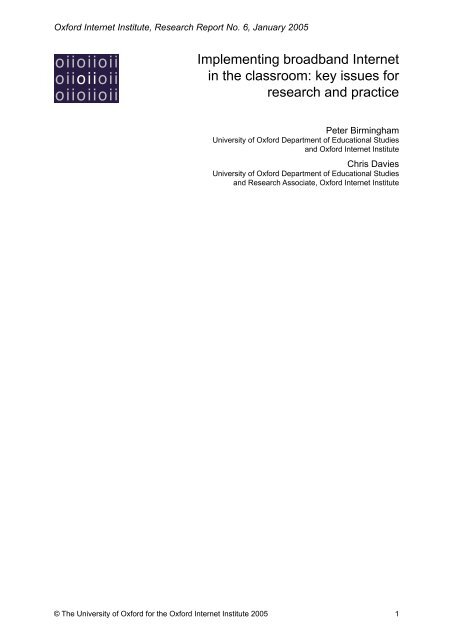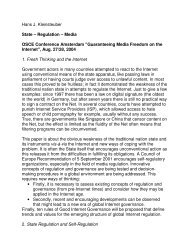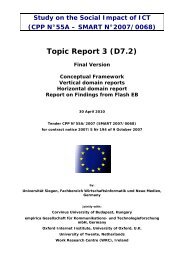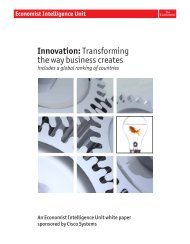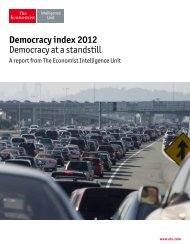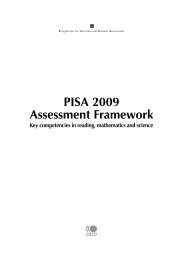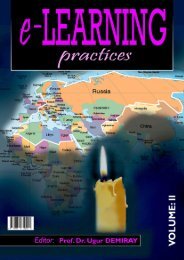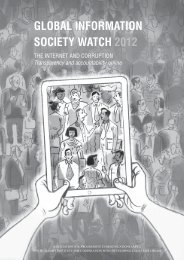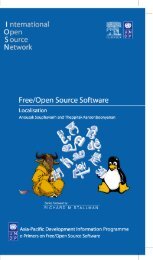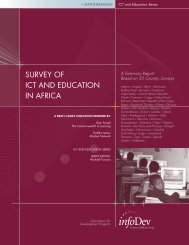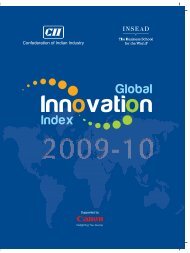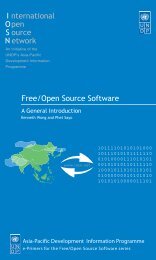Implementing broadband Internet in the classroom: key issues for ...
Implementing broadband Internet in the classroom: key issues for ...
Implementing broadband Internet in the classroom: key issues for ...
You also want an ePaper? Increase the reach of your titles
YUMPU automatically turns print PDFs into web optimized ePapers that Google loves.
Peter Birm<strong>in</strong>gham and Chris DaviesAcknowledgementsWe are extremely grateful to <strong>the</strong> follow<strong>in</strong>g <strong>for</strong> mak<strong>in</strong>g this project possible: <strong>the</strong> HigherEducation Fund<strong>in</strong>g Council <strong>for</strong> England (HEFCE), Microsoft, British EducationalCommunications and Technology Agency (Becta) and <strong>the</strong> Ox<strong>for</strong>dshire CommunityNetwork.ContentsACKNOWLEDGEMENTS 3INTRODUCTION 4Policy and research context 4Ox<strong>for</strong>dshire schools <strong>broadband</strong> study 6The case studies 7Case Study 1: Reception/Year 1 literacy class 7Case Study 2: Year 4 history class 8Case Study 3: Comb<strong>in</strong>ed Years 4/5/6 science class 9Case Study 4: Year 7 ICT class 9Case Study 5: two Year 9 religious education classes 10Case Study 6: Year 10 English class <strong>for</strong> GCSE coursework 11DISCUSSION 11How <strong>the</strong> teachers worked with <strong>broadband</strong> 12How <strong>the</strong> pupils worked with <strong>broadband</strong> 14CONCLUSIONS 18Practical and logistical factors 19Pupil orientation and skills 19Teachers’ assumptions about how to help young people usetechnology <strong>for</strong> learn<strong>in</strong>g 19Key research and development <strong>issues</strong> 21REFERENCES 21NOTES 233
<strong>Implement<strong>in</strong>g</strong> <strong>broadband</strong> <strong>Internet</strong> <strong>in</strong> <strong>the</strong> <strong>classroom</strong>: <strong>key</strong> <strong>issues</strong> <strong>for</strong> research and practiceIntroductionThis paper reports <strong>the</strong> outcome of a study <strong>in</strong>to <strong>classroom</strong> uses of <strong>broadband</strong>-connected<strong>Internet</strong> <strong>in</strong> <strong>the</strong> UK. The study focuses on how some teachers and pupils made use ofthis new teach<strong>in</strong>g and learn<strong>in</strong>g resource dur<strong>in</strong>g <strong>the</strong> period of its <strong>in</strong>itial <strong>in</strong>troduction<strong>in</strong> one local education authority. The sett<strong>in</strong>gs <strong>in</strong>vestigated consisted of a range of<strong>classroom</strong>s, from Reception through to Year 10 (i.e. pupils aged 5 to 15+ years).In l<strong>in</strong>e with Woolgar’s (2002: 6) observation that ‘attention at <strong>the</strong> macro-level gives ra<strong>the</strong>rlittle clue as to how <strong>the</strong>se technologies are actually used and experienced <strong>in</strong> every daypractice’, this small-scale case study focuses on <strong>the</strong> micro level of implementation,seek<strong>in</strong>g to understand whe<strong>the</strong>r and how <strong>the</strong> positive and encourag<strong>in</strong>g claims madeat <strong>the</strong> levels of policy and curriculum development on behalf of <strong>broadband</strong> <strong>Internet</strong> <strong>in</strong>schools are realised when that technology is implemented <strong>in</strong> <strong>in</strong>dividual <strong>classroom</strong>s.Given <strong>the</strong> newness to all <strong>in</strong>volved of this technology with<strong>in</strong> schools, we approachedour research <strong>in</strong> an extremely exploratory and open-m<strong>in</strong>ded way: we wished both tolearn about <strong>the</strong> develop<strong>in</strong>g <strong>broadband</strong>-related practices of <strong>in</strong>dividual teachers andlearners <strong>in</strong> <strong>classroom</strong>s, and we also hoped to sharpen and ref<strong>in</strong>e our understand<strong>in</strong>gsof how research should look at <strong>the</strong>se <strong>issues</strong> and what questions it should be ask<strong>in</strong>g.We believe that <strong>the</strong> opportunity to carry out this research has opened up a numberof important l<strong>in</strong>es <strong>for</strong> fur<strong>the</strong>r enquiry that should be pursued seriously and with someurgency if <strong>the</strong> full potential of this new resource is to be achieved.Policy and research contextBy 2002, accord<strong>in</strong>g to <strong>the</strong> NCES (2003: 3–4), 99% of public schools <strong>in</strong> <strong>the</strong> UnitedStates had access to <strong>the</strong> <strong>Internet</strong>, 94% of which used <strong>broadband</strong> connections ofsome k<strong>in</strong>d. Comparably impressive progress has already been achieved <strong>in</strong> countriesas diverse as South Korea, Japan and Sweden (Cisco Systems 2002: 11–13). TheEuropean Union is rapidly mak<strong>in</strong>g up ground, <strong>in</strong> pursuit of becom<strong>in</strong>g ‘<strong>the</strong> world’s mostcompetitive and dynamic knowledge-based economy by 2010’ (Cisco Systems 2002:14). For example, <strong>the</strong> eEurope 2002 Benchmark<strong>in</strong>g Report (European Commission2002) showed that <strong>the</strong> <strong>in</strong>itial eEurope target of connect<strong>in</strong>g all schools to <strong>the</strong> <strong>Internet</strong>had been all but achieved by 2002, at which time attention was directed to achiev<strong>in</strong>gbetter connections and wider educational use <strong>in</strong> order that ‘all schools and universities,as well as o<strong>the</strong>r <strong>in</strong>stitutions that play a <strong>key</strong> role <strong>in</strong> e-learn<strong>in</strong>g (museums, libraries,archives …), should have <strong>broadband</strong> <strong>Internet</strong> access <strong>for</strong> educational and researchpurposes by end 2005’.The UK is currently more or less <strong>in</strong> l<strong>in</strong>e with <strong>the</strong>se aspirations, aim<strong>in</strong>g to ensure<strong>broadband</strong> connectivity <strong>for</strong> all its schools by 2006, thanks to susta<strong>in</strong>ed governmentcommitment. In particular, <strong>the</strong> Department <strong>for</strong> Education and Skills (DfES) provided£37 million of match<strong>in</strong>g fund<strong>in</strong>g to create eight Regional Broadband Consortia (RBCs),established <strong>in</strong> 1999 to develop <strong>the</strong> provision of <strong>broadband</strong> <strong>Internet</strong> connections toschools through <strong>the</strong> purchase of an appropriate <strong>in</strong>frastructure. Additionally, RBCswere able to develop <strong>the</strong>ir own learn<strong>in</strong>g materials, provide third-party materials and<strong>in</strong>-service tra<strong>in</strong><strong>in</strong>g. Ox<strong>for</strong>dshire, <strong>the</strong> focus of <strong>the</strong> present study, was one of a very smallm<strong>in</strong>ority of local education authorities that opted out of <strong>the</strong> RBC route.4
Peter Birm<strong>in</strong>gham and Chris DaviesThe case <strong>for</strong> comprehensive, high-speed connectivity <strong>in</strong> schools tends to be made <strong>in</strong>broad generic terms, often regardless of <strong>the</strong> realities of considerable local variation(such as geography, technological <strong>in</strong>frastructure, etc.). The follow<strong>in</strong>g def<strong>in</strong>ition from<strong>the</strong> EU summarizes, <strong>in</strong> typical terms, <strong>the</strong> k<strong>in</strong>ds of beneficial outcome claimed <strong>for</strong><strong>the</strong> current massive global <strong>in</strong>vestment <strong>in</strong>to <strong>the</strong>se technologies: ‘e-Learn<strong>in</strong>g: <strong>the</strong> useof new multimedia technologies and <strong>the</strong> <strong>Internet</strong> to improve <strong>the</strong> quality of learn<strong>in</strong>gby facilitat<strong>in</strong>g access to resources and services as well as remote exchanges andcollaboration’ (European Commission 2001: 2).A more recent report from Cisco Systems (2002: 7) specifies <strong>in</strong> slightly more detailwhat it is about <strong>broadband</strong> technology that actually enables such outcomes:… <strong>broadband</strong> allows teachers to <strong>in</strong>corporate <strong>Internet</strong> content <strong>in</strong>to<strong>the</strong>ir lesson plans. Without <strong>broadband</strong> <strong>Internet</strong> access, teachers andstudents end up wait<strong>in</strong>g <strong>for</strong> content to download. Students get restlessand lose <strong>in</strong>terest. By deliver<strong>in</strong>g content quickly, however, <strong>broadband</strong>allows teachers to capitalize on <strong>the</strong> Web as an educational resource.Broadband also enables teachers to br<strong>in</strong>g real-time audio and video<strong>in</strong>to <strong>the</strong>ir <strong>classroom</strong>s. Ra<strong>the</strong>r than po<strong>in</strong>t to a static picture of an Africanelephant, teachers can show <strong>the</strong>se majestic animals march<strong>in</strong>g across<strong>the</strong> savannah—a far more <strong>in</strong>spir<strong>in</strong>g option, particularly to a generationweaned on video games.With<strong>in</strong> <strong>the</strong> EU and beyond, such specifically educational aspirations are also typicallyplaced <strong>in</strong> <strong>the</strong> contexts of lifelong learn<strong>in</strong>g, access to <strong>the</strong> knowledge economy and <strong>the</strong>need to ensure that, by <strong>the</strong> end of 2003, ‘all school-leavers have had <strong>the</strong> chance tobecome digitally literate’ (European Commission 2001: 3). Fur<strong>the</strong>rmore, educationalpolicy and rhetoric <strong>in</strong> <strong>the</strong> UK promotes <strong>the</strong> notion that <strong>broadband</strong> <strong>Internet</strong> specificallyencourages active and <strong>in</strong>dependent learn<strong>in</strong>g. A recent Becta (2003) report claimedthat ‘anecdotal evidence demonstrates <strong>the</strong> effectiveness of <strong>broadband</strong> <strong>in</strong> remov<strong>in</strong>gbarriers to access to ICT [<strong>in</strong><strong>for</strong>mation and communication technology]’, and specifiedhigh speed audio and video, avoidance of time wast<strong>in</strong>g, and encouragement to pupilsto ‘explore <strong>in</strong>dependently and to achieve <strong>the</strong>ir own goals’ as <strong>key</strong> benefits. A draft reportfrom <strong>the</strong> Yorkshire and Humberside Grid <strong>for</strong> Learn<strong>in</strong>g (YHGfL 2002) emphasizes <strong>the</strong>values of speed, lesson pace, lett<strong>in</strong>g ‘<strong>in</strong>dividuals take off on <strong>the</strong>ir own course’ and <strong>the</strong>recognition that, by contrast, earlier uses of ICT had become <strong>in</strong>creas<strong>in</strong>gly seen as animpediment to learn<strong>in</strong>g that teachers tended to avoid.The government’s July 2003 Consultation Document, ‘Towards a Unified e-Learn<strong>in</strong>gStrategy’ (DfES 2003a: 5), most directly expresses <strong>the</strong> policy vision of what mightemerge from such <strong>in</strong>vestment <strong>in</strong> technology, <strong>in</strong> propos<strong>in</strong>g ‘what our education systemcould do, fuelled by e-learn<strong>in</strong>g’. At <strong>the</strong> heart of this vision is <strong>the</strong> aim to ‘empowerlearners—with more active learn<strong>in</strong>g, people of all ages could take responsibility <strong>for</strong>what and how <strong>the</strong>y learn, achiev<strong>in</strong>g <strong>the</strong>ir personal goals as self-directed learners’.Such claims have some foundation <strong>in</strong> earlier <strong>for</strong>ms of ICT-supported practice and havebeen demonstrated to some extent <strong>in</strong> previous research, especially: NCET (1994),Cox (1997), Denn<strong>in</strong>g (1997), Grabe and Grabe (2001), Loveless and Ellis (2001),Harris and K<strong>in</strong>gton (2002), Holloway and Valent<strong>in</strong>e (2002), Furlong et al. (2003),Loveless (2003), and Scrimshaw (2003). Despite such studies, however, relatively5
<strong>Implement<strong>in</strong>g</strong> <strong>broadband</strong> <strong>Internet</strong> <strong>in</strong> <strong>the</strong> <strong>classroom</strong>: <strong>key</strong> <strong>issues</strong> <strong>for</strong> research and practicelittle evidence exists <strong>in</strong> support of such claims <strong>in</strong> relation to <strong>broadband</strong> specifically.What <strong>the</strong>re is consists largely of short-term <strong>classroom</strong>-level <strong>in</strong>spections of regional<strong>broadband</strong> consortia, conducted <strong>in</strong>ternally (<strong>for</strong> example, YHGfL 2002), by Ofsted (see,<strong>for</strong> example, Ofsted 2001) or small case studies relayed at occasional conferences,such as ‘Contagious Creativity’ organized by NESTA Futurelab <strong>in</strong> 2002.In January 2003, Secretary of State <strong>for</strong> Education Charles Clarke, cit<strong>in</strong>g ImpaCT2(DfES 2002), claimed that ‘<strong>the</strong> <strong>in</strong>dependent research shows us that ICT <strong>in</strong> schools,when well used by teachers, is rais<strong>in</strong>g standards‘, and emphasized <strong>the</strong> potential of<strong>broadband</strong> technology <strong>in</strong> this whole process (DfES 2003b: 1–2). Whilst ImpaCT2provided some qualitative case study evidence, its central case was founded on <strong>the</strong>statistical significance of correlations between computer usage and test outcomes<strong>in</strong> different subjects at different stages. Although powerful <strong>in</strong> argu<strong>in</strong>g <strong>for</strong> cont<strong>in</strong>ued<strong>in</strong>vestment <strong>in</strong> ICT generally, ImpaCT2 did not actually manage ei<strong>the</strong>r to answer <strong>the</strong>question of what it is about how teachers use technology that raises standards, or totell us exactly where to focus <strong>the</strong> attention of research <strong>in</strong> order to f<strong>in</strong>d out. As <strong>in</strong>dicatedat <strong>the</strong> start of this paper, <strong>the</strong>se are <strong>the</strong> <strong>issues</strong> that our own modest <strong>in</strong>vestigationsaimed to explore with specific respect to <strong>broadband</strong>.Ox<strong>for</strong>dshire schools <strong>broadband</strong> studyDur<strong>in</strong>g <strong>the</strong> first two terms of universal <strong>broadband</strong> connectivity <strong>in</strong> Ox<strong>for</strong>dshire schools,between October 2003 and March 2004, we studied sequences of lessons <strong>in</strong>volv<strong>in</strong>g<strong>the</strong> use of <strong>broadband</strong> taught <strong>in</strong> six <strong>classroom</strong>s from across <strong>the</strong> full school age range.We were able to record <strong>the</strong> lessons as a whole, to focus on specific pupils or pairs ofpupils as <strong>the</strong>y worked with <strong>broadband</strong>, and to discuss <strong>the</strong> lessons afterwards with <strong>the</strong>teachers. At <strong>the</strong> heart of <strong>the</strong>se <strong>in</strong>vestigations was <strong>the</strong> video-record<strong>in</strong>g of pupils work<strong>in</strong>gwith <strong>broadband</strong> technology. We were subsequently able to analyse <strong>the</strong>se record<strong>in</strong>gs<strong>in</strong> considerable detail.Proponents of video analysis <strong>in</strong> workplace studies and sociology po<strong>in</strong>t to <strong>the</strong> capacityof video to enable <strong>the</strong> analyst to exam<strong>in</strong>e materials extensively, repeatedly and <strong>in</strong> f<strong>in</strong>edetail, as well as to present data <strong>in</strong> close to <strong>the</strong>ir orig<strong>in</strong>al <strong>for</strong>m <strong>in</strong> order to augmentdescriptions, document conclusions or allow alternative <strong>in</strong>terpretations. For thisparticular research project, with a digital camcorder and external directional microphonewe were able to capture, preserve and retrieve exactly what pupils said and did as<strong>the</strong>y worked with <strong>broadband</strong>-supported ICTs. We recorded pupils’ <strong>in</strong>teractions with<strong>the</strong>ir teachers as well as <strong>the</strong>ir conversations with each o<strong>the</strong>r, <strong>the</strong>ir gestures and <strong>the</strong>iruse of <strong>the</strong> <strong>key</strong>board, mouse and additional paper-based resources and materials. Wetook measures advocated <strong>in</strong> <strong>the</strong> video-analysis research literature (e.g. Goodw<strong>in</strong>,1981, 1994; Heath and Luff, 1993) to m<strong>in</strong>imize <strong>the</strong> obtrusiveness of video <strong>in</strong> researchsett<strong>in</strong>gs. We <strong>the</strong>n prepared detailed transcripts of conversations and o<strong>the</strong>r visuallyavailable aspects of <strong>classroom</strong> <strong>in</strong>teraction. The transcription system we used is onewhich we modified ourselves from Gail Jefferson’s foundational transcription system<strong>for</strong> Conversation Analysis (Schenke<strong>in</strong> 1978: xi–xvi).In addition, <strong>the</strong> post-lesson <strong>in</strong>terviews enabled us to explore with certa<strong>in</strong> of <strong>the</strong>teachers <strong>the</strong> rationales <strong>for</strong> <strong>the</strong>ir lessons, <strong>the</strong> extent and ways <strong>in</strong> which <strong>the</strong>ir <strong>in</strong>itial plansaimed <strong>for</strong> certa<strong>in</strong> approaches to learn<strong>in</strong>g or learn<strong>in</strong>g outcomes, and any ways <strong>in</strong> which<strong>the</strong>se <strong>in</strong>tentions turned out differently <strong>in</strong> practice. In some cases we were also able6
Peter Birm<strong>in</strong>gham and Chris Daviesto supplement <strong>the</strong> data with documentary evidence such as pupil worksheets andexamples of pupils’ work.The case studiesWe first of all present a brief descriptive account of each <strong>in</strong>dividual case study <strong>in</strong> turn,as <strong>the</strong> basis <strong>for</strong> a subsequent evidence-based discussion of <strong>key</strong> <strong>issues</strong> and <strong>the</strong>mesthat have emerged from <strong>the</strong> six case studies as a whole.Case Study 1: Reception/Year 1 literacy classThis study <strong>in</strong>volved a Reception/Year 1 class focus<strong>in</strong>g on learn<strong>in</strong>g consonant–vowel–consonant (CVC) words, as part of <strong>the</strong> National Literacy Strategy. The teacher’s<strong>in</strong>troduction to <strong>the</strong> lesson conveys someth<strong>in</strong>g of <strong>the</strong> wide range of activities undertakenby pupils <strong>in</strong> this class, sometimes work<strong>in</strong>g toge<strong>the</strong>r as a whole class, sometimesmov<strong>in</strong>g <strong>in</strong>to smaller groups (e.g. ‘Fireman’, ‘Doctors’, etc.) and sometimes work<strong>in</strong>g on<strong>the</strong>ir own; at all times orchestrated by <strong>the</strong> class teacher:Teacher: We’re go<strong>in</strong>g to watch <strong>the</strong> video and <strong>the</strong>n after <strong>the</strong> videoMrs Smith is go<strong>in</strong>g to come at some po<strong>in</strong>t to take <strong>the</strong> Firemen <strong>for</strong>hand-writ<strong>in</strong>g (.) but I will give you some work to do as well so whenyou come back from work<strong>in</strong>g with Mrs Smith you can get on withthat work okay (.) and that work will be to do with what we’re go<strong>in</strong>gto watch on Words and Pictures (.) <strong>the</strong> Doctors and <strong>the</strong> Police whenwe’ve watched <strong>the</strong> video we’re go<strong>in</strong>g to do some work on <strong>the</strong> carpetand each group’s got work to do and <strong>the</strong>n some of you are go<strong>in</strong>gto work on Jim’s Crankophone okay (.) do what we did yesterdayafternoon and see if we can pr<strong>in</strong>t it off (.) if you get stuck just f<strong>in</strong>d meokay?With<strong>in</strong> this particular work<strong>in</strong>g context, <strong>the</strong> two-pupil computer workstations constitutejust one among many different k<strong>in</strong>ds of resource used by <strong>the</strong>se children. It was onlywhen <strong>the</strong> teacher used <strong>the</strong> <strong>in</strong>teractive whiteboard, typically with <strong>the</strong> whole class sitt<strong>in</strong>gon <strong>the</strong> floor around it, that technology took centre stage <strong>in</strong> this <strong>classroom</strong>.The ultimate focus <strong>for</strong> this literacy lesson was CVC words, an area of phonic knowledge<strong>in</strong>troduced <strong>in</strong> <strong>the</strong> Year 1 Term 1 objectives of <strong>the</strong> National Literacy Strategy Framework,but this focus emerged only gradually out of a number of topics and activities. Theclass as a whole first watched an episode of <strong>the</strong> BBC programme ‘Words and Pictures’.Then <strong>the</strong>y divided <strong>in</strong>to three smaller groups, some practis<strong>in</strong>g <strong>the</strong>ir handwrit<strong>in</strong>g, <strong>the</strong>o<strong>the</strong>rs us<strong>in</strong>g ei<strong>the</strong>r cubes and a ‘board’ or a worksheet to practise assembl<strong>in</strong>g CVCwords.Dur<strong>in</strong>g this time, four pupils took turns to sit at <strong>the</strong> s<strong>in</strong>gle <strong>Internet</strong>-connected workstationto play ‘Jim’s Crankophone’ on <strong>the</strong> BBC Learn<strong>in</strong>g website. 1 This is a Flash-animatedgame <strong>in</strong> which players listen to words emitted from <strong>the</strong> ‘Crankophone’ and select whichof two vowels offered to <strong>the</strong>m <strong>the</strong>y can hear <strong>in</strong> <strong>the</strong> middle of <strong>the</strong> word. Correct answersare added to a list which can <strong>the</strong>n be personalized and pr<strong>in</strong>ted out: accord<strong>in</strong>g to <strong>the</strong>BBC website, <strong>the</strong> game is ‘an exercise <strong>in</strong> auditory discrim<strong>in</strong>ation of medial vowels,often <strong>the</strong> most difficult to hear and identify when learn<strong>in</strong>g phonics’. Each pupil worked7
<strong>Implement<strong>in</strong>g</strong> <strong>broadband</strong> <strong>Internet</strong> <strong>in</strong> <strong>the</strong> <strong>classroom</strong>: <strong>key</strong> <strong>issues</strong> <strong>for</strong> research and practiceon <strong>the</strong>ir own, unsupervised, <strong>for</strong> around 4 m<strong>in</strong>utes, f<strong>in</strong>ish<strong>in</strong>g up by be<strong>in</strong>g <strong>in</strong>structed topr<strong>in</strong>t out <strong>the</strong>ir f<strong>in</strong>ished work.Pr<strong>in</strong>t<strong>in</strong>g proved troublesome both because <strong>the</strong> pupils experienced difficultiesaccess<strong>in</strong>g <strong>the</strong> pr<strong>in</strong>t<strong>in</strong>g facility and <strong>in</strong>struct<strong>in</strong>g <strong>the</strong> computer to pr<strong>in</strong>t, and because of<strong>the</strong> considerable time it took to pr<strong>in</strong>t out work—about <strong>the</strong> same length of time pupilshad taken to play <strong>the</strong> game. Because of <strong>the</strong> delay, only half <strong>the</strong> number of pupils <strong>the</strong>teacher had orig<strong>in</strong>ally selected to use <strong>the</strong> resource actually did so.Case Study 2: Year 4 history classThe topic of <strong>the</strong> lesson studied, <strong>the</strong> mummification process <strong>in</strong> Ancient Egypt, relatesto <strong>the</strong> focus <strong>in</strong> Key Stage 2 of <strong>the</strong> National Curriculum <strong>for</strong> history on study of a pastsociety (item 13 of Knowledge, Skills and Understand<strong>in</strong>g). The lesson took place <strong>in</strong><strong>the</strong> school’s ICT suite, beg<strong>in</strong>n<strong>in</strong>g with <strong>the</strong> teacher discuss<strong>in</strong>g with <strong>the</strong> class as a wholeits recent visit to a museum. Then, on an <strong>in</strong>teractive whiteboard at <strong>the</strong> head of <strong>the</strong><strong>classroom</strong>, <strong>the</strong> teacher displayed an onl<strong>in</strong>e ‘<strong>in</strong>teractive game’, ‘Prepare a Mummy <strong>for</strong>Burial!’, on <strong>the</strong> website <strong>for</strong> <strong>the</strong> ‘Kids’ Corner’ of <strong>the</strong> education section of <strong>the</strong> OrientalInstitute of <strong>the</strong> University of Chicago (USA). 2 This site had been recommended toher by ICT staff <strong>in</strong> <strong>the</strong> local education advisory service. The game was a fairly ligh<strong>the</strong>artedFlash animation, <strong>in</strong> <strong>the</strong> style of ‘Horrible Histories’, <strong>in</strong> which players prepare afictitious ancient Egyptian, Seneb, <strong>for</strong> <strong>the</strong> afterlife by remov<strong>in</strong>g his bra<strong>in</strong> and <strong>in</strong>ternalorgans, dry<strong>in</strong>g out his body with salt and wrapp<strong>in</strong>g it <strong>in</strong> l<strong>in</strong>en.The teacher focused most of her <strong>in</strong>structional guidance on process ra<strong>the</strong>r than contentthroughout <strong>the</strong> lesson, both <strong>in</strong> terms of us<strong>in</strong>g <strong>the</strong> technology (such as expla<strong>in</strong><strong>in</strong>g how<strong>the</strong> ‘Favorites’ capability works on a computer), and <strong>in</strong> terms of <strong>the</strong> importance <strong>in</strong> thislesson of clearly record<strong>in</strong>g <strong>the</strong> <strong>in</strong><strong>for</strong>mation about mummification that <strong>the</strong>y discoverfrom <strong>the</strong> website activity:Teacher: <strong>the</strong>re are some very important bits of <strong>in</strong><strong>for</strong>mation up here(.) and <strong>the</strong>re is some live words which you can actually read as wellas do<strong>in</strong>g what you’re supposed to be do<strong>in</strong>g (.) so you can read <strong>the</strong><strong>in</strong><strong>for</strong>mation (.) you could try <strong>the</strong> live words and see what <strong>in</strong><strong>for</strong>mationit comes up with o<strong>the</strong>rwise you’re do<strong>in</strong>g as it’s ask<strong>in</strong>g you to do (.)you’re actually follow<strong>in</strong>g <strong>the</strong> <strong>in</strong>structions. It’s important that you dolook here though because next week we’re go<strong>in</strong>g to be mak<strong>in</strong>g a littlesheet of <strong>in</strong>structions so that you can give that to somebody and saythis is how to make a mummy…Technical problems with <strong>the</strong> computers meant <strong>the</strong> game could only be accessed onfour of <strong>the</strong> 15 mach<strong>in</strong>es. The teacher reassembled all pupils, except those seated at<strong>the</strong> four work<strong>in</strong>g computers around <strong>the</strong> whiteboard, and worked through <strong>the</strong> game with<strong>the</strong>m by <strong>in</strong>vit<strong>in</strong>g <strong>in</strong>dividual pupils <strong>in</strong> turn to attempt <strong>the</strong> various tasks on <strong>the</strong> <strong>in</strong>teractivewhiteboard itself <strong>in</strong> front of <strong>the</strong> rest of <strong>the</strong> class. This was only partially successfulbecause <strong>the</strong> pupils experienced difficulty with dragg<strong>in</strong>g icons around <strong>the</strong> whiteboard,so that <strong>the</strong> teacher frequently stepped <strong>in</strong> to help. This was an arduous processand towards <strong>the</strong> end one pupil, with no prompt<strong>in</strong>g, used <strong>the</strong> whiteboard-connectedcomputer ra<strong>the</strong>r than <strong>the</strong> whiteboard itself, thus elim<strong>in</strong>at<strong>in</strong>g <strong>the</strong> problem.8
Peter Birm<strong>in</strong>gham and Chris DaviesCase Study 3: Comb<strong>in</strong>ed Years 4/5/6 science classThis science lesson on magnetism related directly to <strong>the</strong> National Curriculum (Sc4/2Physical Processes <strong>in</strong> Key Stage 2 science) and was run by two teachers: <strong>the</strong> ScienceCoord<strong>in</strong>ator and a newly qualified teacher. It took place <strong>in</strong> a <strong>classroom</strong> which conta<strong>in</strong>eda network of four PCs. For <strong>the</strong> Year 6 pupils, <strong>the</strong> lesson was a one-off revision session<strong>in</strong> advance of <strong>the</strong>ir Standard Assessment Tests (SATs); <strong>for</strong> <strong>the</strong> Year 5s, it was anopportunity to revise and extend upon lessons <strong>the</strong>y had had one year earlier; and <strong>for</strong><strong>the</strong> Year 4s it was an <strong>in</strong>troduction to magnetism. This was a complex and busy lesson<strong>in</strong> which several resources were used <strong>in</strong> support of a variety of discrete activities:props and apparatus, m<strong>in</strong>erals, ‘concept cartoons’, worksheets, an experiment and aquiz:Teacher 1: (displays concept cartoon on <strong>in</strong>teractive whiteboard) rightyou’ve all got <strong>the</strong> concept cartoon <strong>in</strong> front of you (.) some of you havewritten a lot on it and that’s great (.) what we’re go<strong>in</strong>g to do now isa practical activity (.) really we want to f<strong>in</strong>d out whe<strong>the</strong>r this chap at<strong>the</strong> top here is on <strong>the</strong> right track (.) he’s say<strong>in</strong>g I th<strong>in</strong>k magnetic fieldswork through anyth<strong>in</strong>g and that’s what you’re go<strong>in</strong>g to test out thisafternoon.Teacher 2: <strong>the</strong>se are very very weak magnets (.) I had to takeeveryth<strong>in</strong>g off my fridge this morn<strong>in</strong>g (.) so you’ve got all my fridgemagnets […] right all you’ve got is a piece of paper (.) a piece ofplastic (.) a piece of wood (.) a magnet (.) and a paperclipThe <strong>classroom</strong>’s <strong>in</strong>teractive whiteboard was used extensively, <strong>in</strong> order to display to<strong>the</strong> whole class animations about magnetism and a comprehension quiz; both froman American website. 3 Pupils took turns to use <strong>the</strong> four PCs to consult <strong>the</strong> magnetismsection of He<strong>in</strong>emann Explore. As <strong>the</strong>y did so, <strong>the</strong> teachers asked <strong>the</strong>m to payparticular attention to <strong>the</strong> specialist vocabulary associated with magnetism. Each pupilspent an average of 4 m<strong>in</strong>utes alone at <strong>the</strong> PC, dur<strong>in</strong>g which time <strong>the</strong>y were free toexplore <strong>the</strong> He<strong>in</strong>emann site without restriction.Case Study 4: Year 7 ICT classThis class was study<strong>in</strong>g elements of <strong>the</strong> Key Stage 3 ICT strategy. The lessons werepart of a longer sequence <strong>in</strong> <strong>the</strong> ICT subject area, <strong>in</strong> which <strong>the</strong> teacher was cover<strong>in</strong>g <strong>the</strong>Key Stage 3 National Strategy <strong>for</strong> ICT with his Year 7 class. The Framework Objectives<strong>for</strong> Unit 7.2 focus on search<strong>in</strong>g, select<strong>in</strong>g and us<strong>in</strong>g onl<strong>in</strong>e <strong>in</strong><strong>for</strong>mation sources, andthis teacher’s aim was that his pupils should be able to expla<strong>in</strong> how to search <strong>for</strong><strong>in</strong><strong>for</strong>mation <strong>for</strong> a particular task, ref<strong>in</strong>e <strong>the</strong>ir search and evaluate <strong>in</strong><strong>for</strong>mation from <strong>the</strong><strong>Internet</strong>, while understand<strong>in</strong>g that miss<strong>in</strong>g or <strong>in</strong>accurate <strong>in</strong><strong>for</strong>mation can mislead.Teacher: if we’re do<strong>in</strong>g a web search and here’s our <strong>key</strong> wordsup on here (po<strong>in</strong>t<strong>in</strong>g to whiteboard) <strong>for</strong> this lesson (.) we’ve got tomake sure that we’ve got a very clear image <strong>in</strong> our head of what<strong>in</strong><strong>for</strong>mation we’re gett<strong>in</strong>g off <strong>the</strong> <strong>Internet</strong> (.) and is that <strong>in</strong><strong>for</strong>mationtrue (.) so what we’re go<strong>in</strong>g to have a look at today are <strong>the</strong>se words9
<strong>Implement<strong>in</strong>g</strong> <strong>broadband</strong> <strong>Internet</strong> <strong>in</strong> <strong>the</strong> <strong>classroom</strong>: <strong>key</strong> <strong>issues</strong> <strong>for</strong> research and practice(.) we’re go<strong>in</strong>g to have a look at <strong>in</strong><strong>for</strong>mation (.) and […] we’re go<strong>in</strong>g toask ourselves is it reliableThe teacher encouraged <strong>the</strong> pupils to th<strong>in</strong>k about different sources of <strong>in</strong><strong>for</strong>mation, suchas libraries, computers, encyclopaedias, teachers and o<strong>the</strong>rs. The example of schoollibrary books was used <strong>for</strong> an exercise <strong>in</strong> search<strong>in</strong>g <strong>for</strong> <strong>in</strong><strong>for</strong>mation by consult<strong>in</strong>gcontents pages and <strong>in</strong>dexes, look<strong>in</strong>g <strong>for</strong> ‘one piece of knowledge that you didn’t knowbe<strong>for</strong>e’. The majority of both lessons was spent away from <strong>the</strong> computers, work<strong>in</strong>g<strong>in</strong>dividually or as a whole class on <strong>the</strong> Unit’s worksheets. Pupils’ first and only use of<strong>the</strong> <strong>Internet</strong> <strong>in</strong> <strong>the</strong> second lesson came 40 m<strong>in</strong>utes <strong>in</strong>to <strong>the</strong> lesson and lasted just 10m<strong>in</strong>utes. They were asked to work <strong>in</strong>dividually us<strong>in</strong>g <strong>the</strong> Pupil Resource 8 worksheetto evaluate <strong>the</strong> quality of particular websites relat<strong>in</strong>g to <strong>the</strong> wreck of <strong>the</strong> Mary Rose, asixteenth century warship.The first occasion on which <strong>the</strong> teacher asked pupils to work <strong>in</strong>dividually at <strong>the</strong>ir ownmach<strong>in</strong>e, <strong>in</strong> order to f<strong>in</strong>d out about <strong>the</strong> local wea<strong>the</strong>r from <strong>the</strong> BBC website, provedproblematic: <strong>the</strong> network had been switched off <strong>for</strong> test<strong>in</strong>g without <strong>the</strong> teacher’sknowledge, and access was sporadic and slow when it was switched on aga<strong>in</strong>. Theteacher conducted <strong>the</strong> rema<strong>in</strong>der of <strong>the</strong> first lesson on a whole-class basis around <strong>the</strong>suite’s whiteboard.Case Study 5: two Year 9 religious education classesThis case study comprises one lesson, study<strong>in</strong>g <strong>the</strong> build<strong>in</strong>g of Durham Ca<strong>the</strong>dral, wi<strong>the</strong>ach of two Year 9 religious education (RE) classes, as part of <strong>the</strong> school’s specialistfocus on eng<strong>in</strong>eer<strong>in</strong>g. Both lessons took place <strong>in</strong> an English <strong>classroom</strong> with a bank of10 PCs, ra<strong>the</strong>r than <strong>in</strong> <strong>the</strong> much larger but fully booked ICT suite as <strong>the</strong> teacher hadorig<strong>in</strong>ally <strong>in</strong>tended. This meant that some pupils had to work <strong>in</strong> groups of four, tak<strong>in</strong>gturns with <strong>the</strong>ir jo<strong>in</strong>t task.Each class was undertak<strong>in</strong>g an eng<strong>in</strong>eer<strong>in</strong>g project about build<strong>in</strong>g ca<strong>the</strong>drals: <strong>the</strong>school had recently acquired eng<strong>in</strong>eer<strong>in</strong>g status and all teachers, irrespective of <strong>the</strong>irspecialism, had been asked to <strong>in</strong>corporate <strong>the</strong> topic of eng<strong>in</strong>eer<strong>in</strong>g <strong>in</strong>to elements of <strong>the</strong>irteach<strong>in</strong>g. Prior to <strong>the</strong> case study lessons, both classes had watched a video about <strong>the</strong>history of Durham Ca<strong>the</strong>dral and begun work<strong>in</strong>g <strong>in</strong> pairs on PowerPo<strong>in</strong>t presentationsabout <strong>the</strong> ca<strong>the</strong>dral, pay<strong>in</strong>g particular attention to eng<strong>in</strong>eer<strong>in</strong>g <strong>in</strong>novations such asvaulted roofs, po<strong>in</strong>ted arches and fly<strong>in</strong>g buttresses. The teacher had prepared a listof websites <strong>in</strong> advance <strong>for</strong> pupils to visit <strong>in</strong> order to consult and collect textual andpictorial resources to <strong>in</strong>corporate <strong>in</strong>to <strong>the</strong>ir presentations:Teacher: what th<strong>in</strong>gs can we <strong>in</strong>clude do you th<strong>in</strong>k <strong>in</strong> our PowerPo<strong>in</strong>ts(.) we talked about ribbed vaults (.) that was one of <strong>the</strong> three newmethods (.) talk about <strong>the</strong> history (.) buttresses (.) can anyoneremember what <strong>the</strong> third of those th<strong>in</strong>gs were (.) po<strong>in</strong>ted arches (.)[opens website document on whiteboard] right see if you can f<strong>in</strong>dsometh<strong>in</strong>g on those <strong>in</strong> those websites10
Peter Birm<strong>in</strong>gham and Chris DaviesCase Study 6: Year 10 English class <strong>for</strong> GCSE courseworkThis case study comprises two consecutive lessons with one Year 10 class study<strong>in</strong>g<strong>the</strong> social and cultural context of <strong>the</strong> notorious Derek Bentley shoot<strong>in</strong>g <strong>in</strong>cident <strong>in</strong>1950s England. The aim was to help <strong>in</strong><strong>for</strong>m a Media Studies coursework essay that<strong>the</strong>y were required to write <strong>for</strong> <strong>the</strong>ir English General Certificate of Secondary Education(GCSE) course. In preparation <strong>for</strong> <strong>the</strong> essay, <strong>the</strong> pupils had studied a report of <strong>the</strong><strong>in</strong>cident <strong>in</strong> <strong>the</strong> Daily Mail from 3 November 1952 and a representation of <strong>the</strong> <strong>in</strong>cident<strong>in</strong> <strong>the</strong> film ‘Let Him Have It!’ Both lessons took place <strong>in</strong> an ICT suite with pupils work<strong>in</strong>g<strong>in</strong> pairs at a PC.The teacher began <strong>the</strong> first lesson by hand<strong>in</strong>g out a worksheet she had written herself,headed ‘British Society <strong>in</strong> <strong>the</strong> 1950s’. The worksheet expla<strong>in</strong>ed that:… <strong>in</strong> order to fully understand <strong>the</strong> Derek Bentley case, it is vital thatyou have a good work<strong>in</strong>g knowledge of <strong>the</strong> society that he lived <strong>in</strong>,and its values and traditions. As part of your research, you are be<strong>in</strong>ggiven <strong>the</strong> opportunity to use <strong>the</strong> <strong>Internet</strong> to <strong>in</strong>vestigate <strong>the</strong> context of<strong>the</strong> <strong>in</strong>cident so that you can apply any relevant <strong>in</strong><strong>for</strong>mation to youressay.The worksheet conta<strong>in</strong>ed four questions on 1950s popular culture, <strong>the</strong> emergence of<strong>the</strong> teenager, crime and punishment <strong>in</strong> <strong>the</strong> 1950s and <strong>the</strong> history of capital punishment<strong>in</strong> <strong>the</strong> UK. Each question was accompanied by between one and three ‘helpfulwebsites’ <strong>the</strong> teacher had provided to help pupils with <strong>the</strong>ir answers. The worksheetalso conta<strong>in</strong>ed a list of Google <strong>key</strong> words <strong>the</strong> teacher had selected to help pupilsproduce some ‘background notes’. The teacher devoted <strong>the</strong> entirety of both lessons togett<strong>in</strong>g <strong>the</strong> pupils to work through <strong>the</strong> worksheet, regularly monitor<strong>in</strong>g, assist<strong>in</strong>g andquestion<strong>in</strong>g her pupils as <strong>the</strong>y worked <strong>in</strong> pairs around a computer.DiscussionClassroom <strong>broadband</strong> is worthy of study because it constitutes a significant momentof development and change <strong>in</strong> <strong>the</strong> usability of an exist<strong>in</strong>g educational technology: its<strong>in</strong>troduction is <strong>in</strong>tended to make possible <strong>the</strong> normal and regular use of <strong>the</strong> <strong>Internet</strong><strong>in</strong> <strong>classroom</strong>s, result<strong>in</strong>g <strong>in</strong> a broad <strong>in</strong>crease <strong>in</strong> use of ICTs generally. Althoughsome teachers we contacted were not explicitly conscious of <strong>the</strong> implementation of<strong>broadband</strong>, <strong>the</strong>re was a general awareness of <strong>the</strong> fact that <strong>Internet</strong> access had becomemore feasible and convenient and that ‘<strong>broadband</strong>’, whatever that was, had made thatpossible. All <strong>the</strong> case study teachers were quite clear about <strong>the</strong> fact that <strong>the</strong>y weretry<strong>in</strong>g to take advantage of a powerful new resource, and were <strong>in</strong>fluenced both <strong>in</strong> <strong>the</strong>irlesson-plann<strong>in</strong>g decisions and <strong>classroom</strong> practice by <strong>the</strong> fact of its availability andimproved functionality as a means of access<strong>in</strong>g <strong>the</strong> <strong>Internet</strong>.This <strong>in</strong>vestigation focused upon a period of learn<strong>in</strong>g and transition <strong>for</strong> teachers:each of <strong>the</strong>se cases represents first-stage and experimental steps towards what isbroadly promoted as a desirable future state of normalized and understood usability.The teachers <strong>in</strong> this study were, without exception, enterpris<strong>in</strong>g, adaptable andprepared to work through uncerta<strong>in</strong>ty and unfamiliarity <strong>in</strong> order to ga<strong>in</strong> <strong>the</strong> benefits11
<strong>Implement<strong>in</strong>g</strong> <strong>broadband</strong> <strong>Internet</strong> <strong>in</strong> <strong>the</strong> <strong>classroom</strong>: <strong>key</strong> <strong>issues</strong> <strong>for</strong> research and practiceof this technology. In analys<strong>in</strong>g <strong>the</strong> case studies outl<strong>in</strong>ed above, we were look<strong>in</strong>g <strong>for</strong>patterns and clues that told us someth<strong>in</strong>g about <strong>the</strong> k<strong>in</strong>ds of practice that seem to betak<strong>in</strong>g shape around <strong>broadband</strong> <strong>Internet</strong> use <strong>in</strong> <strong>the</strong> <strong>classroom</strong>, and about any aspectsof that practice which deserve to be fostered or avoided. The <strong>issues</strong> and commentswhich follow are solely <strong>in</strong>tended to add to our understand<strong>in</strong>gs about mov<strong>in</strong>g <strong>for</strong>wardthrough this period of transition, ra<strong>the</strong>r than to question whe<strong>the</strong>r or not <strong>classroom</strong>based<strong>Internet</strong> is a good idea. It seems to us that it is already a fact of life, and ef<strong>for</strong>tshould be directed now to mak<strong>in</strong>g <strong>the</strong> most of that fact.How <strong>the</strong> teachers worked with <strong>broadband</strong>With <strong>the</strong> exception of Case Study 1, technology featured heavily <strong>in</strong> all <strong>the</strong> case studylessons as a lead<strong>in</strong>g element <strong>in</strong> <strong>the</strong> lesson plan, with a considerable proportionof teacher talk <strong>in</strong> <strong>the</strong> actual lesson devoted to expla<strong>in</strong><strong>in</strong>g to pupils how to use it,and with pupil use <strong>in</strong> turn constitut<strong>in</strong>g <strong>the</strong> climax or ma<strong>in</strong> event of <strong>the</strong> lesson. Ourcommunications with a wider group of Ox<strong>for</strong>dshire teachers, prior to and dur<strong>in</strong>g <strong>the</strong>study reported here, suggest that <strong>broadband</strong> <strong>Internet</strong> was also often be<strong>in</strong>g used <strong>in</strong><strong>classroom</strong>s <strong>for</strong> brief <strong>for</strong>ays onto <strong>the</strong> <strong>Internet</strong>, usually <strong>for</strong> <strong>the</strong> purpose of <strong>in</strong><strong>for</strong>mationga<strong>the</strong>r<strong>in</strong>g <strong>in</strong> <strong>the</strong> course of several o<strong>the</strong>r activities dur<strong>in</strong>g a lesson, and <strong>in</strong> conjunctionwith a wide range of o<strong>the</strong>r resources. In such lessons, <strong>broadband</strong> <strong>Internet</strong> might becharacterized as an embedded resource, used with m<strong>in</strong>imal attention paid to <strong>issues</strong>about technology or to any attempt to develop digital literacy, as dist<strong>in</strong>ct from moretechnology-dom<strong>in</strong>ated lessons where it is a <strong>for</strong>egrounded resource, compet<strong>in</strong>g with<strong>the</strong> subject matter of <strong>the</strong> lesson <strong>for</strong> <strong>the</strong> attention of pupils and teacher alike.In all <strong>the</strong> cases reported here, apart from <strong>the</strong> first, <strong>broadband</strong> was to some extentor ano<strong>the</strong>r a <strong>for</strong>egrounded resource. Whilst this was partly <strong>the</strong> result of <strong>the</strong> fact thatteachers were less <strong>in</strong>cl<strong>in</strong>ed to offer up <strong>the</strong>ir brief (embedded) uses of <strong>Internet</strong> to outsideobservation than was <strong>the</strong> case with more substantial (<strong>for</strong>egrounded) uses, we suspectthat it is still more generally <strong>the</strong> case that <strong>the</strong> <strong>Internet</strong> is used <strong>in</strong> this <strong>for</strong>egrounded way.Teachers usually need to go through complex processes of book<strong>in</strong>g computer suitesand relocat<strong>in</strong>g <strong>the</strong>ir classes to <strong>the</strong>se, and <strong>the</strong>re<strong>for</strong>e tend to try to make <strong>the</strong> most ofsuch occasions: dur<strong>in</strong>g this period of transition at least, us<strong>in</strong>g <strong>the</strong> <strong>Internet</strong> <strong>in</strong> class islikely to be experienced by pupils as a relatively ‘big deal’, perhaps disproportionatelyso. In some cases, such as Case Study 2, problems with <strong>the</strong> technology necessitatedexaggerated attention to <strong>the</strong> work<strong>in</strong>gs of <strong>the</strong> technology throughout <strong>the</strong> lesson, but <strong>in</strong>every case we were impressed by <strong>the</strong> skill of teachers <strong>in</strong> ei<strong>the</strong>r solv<strong>in</strong>g unexpectedproblems with <strong>the</strong> technology, or <strong>in</strong> adapt<strong>in</strong>g <strong>the</strong>ir lesson plan <strong>in</strong> order to m<strong>in</strong>imize lossof momentum.Activities utiliz<strong>in</strong>g <strong>the</strong> <strong>Internet</strong> divided fairly evenly between <strong>the</strong> onl<strong>in</strong>e educationalgames play<strong>in</strong>g <strong>in</strong> Case Studies 1, 2 and 3 (i.e. <strong>in</strong>teractive and multimedia activities<strong>in</strong>corporat<strong>in</strong>g some element of fun or playfulness <strong>in</strong> order to encourage learn<strong>in</strong>g,ra<strong>the</strong>r than full-blown computer games-play<strong>in</strong>g activities) and carry<strong>in</strong>g out <strong>in</strong><strong>for</strong>mationsearches on largely pre-selected sites, transferr<strong>in</strong>g or adapt<strong>in</strong>g what <strong>the</strong>y found ei<strong>the</strong>rto notes or presentations (Case Studies 4, 5 and 6). In all cases, <strong>the</strong> activities hadbeen carefully pre-planned by <strong>the</strong> teachers, to <strong>the</strong> extent that websites were preselected,and guidance was provided to pupils about how to use <strong>the</strong>se. In <strong>the</strong> casesof educational games-play<strong>in</strong>g, <strong>the</strong> pupils were told clearly and precisely how long to12
Peter Birm<strong>in</strong>gham and Chris Daviesspend on an activity, and how to take notes on what was learnt from it. In <strong>the</strong> case ofsearches, <strong>key</strong>words were provided to guide wider searches where appropriate, anddetailed guidance (generally written <strong>in</strong> <strong>the</strong> <strong>for</strong>m of a worksheet, or <strong>in</strong>structions projectedon <strong>the</strong> class screen) was given to <strong>the</strong> pupils about <strong>the</strong> parameters of searches and<strong>the</strong> questions to be answered. There were no <strong>in</strong>stances of remote exchanges andcollaboration <strong>in</strong> <strong>the</strong>se studies, although it is worth not<strong>in</strong>g that prior to this research(and <strong>the</strong>re<strong>for</strong>e not video-recorded) we had observed <strong>the</strong> Case Study 5 teacher runwhat appeared to be a successful e-mail project <strong>in</strong>volv<strong>in</strong>g an asynchronous debatebetween her pupils and high school students <strong>in</strong> Kentucky (USA) on <strong>the</strong> topic of capitalpunishment.In none of <strong>the</strong> recorded <strong>in</strong>stances did <strong>the</strong> teachers simply let <strong>the</strong> pupils make use of<strong>Internet</strong> resources <strong>in</strong> unstructured ways, to <strong>the</strong> extent that <strong>the</strong>y could be said to havebeen enabled to ‘explore <strong>in</strong>dependently and to achieve <strong>the</strong>ir own goals’ (Becta 2003,quoted above) or to ‘take off on <strong>the</strong>ir own course’ as <strong>in</strong>dividuals (YHGfL 2002, quotedabove). The implication, <strong>in</strong> terms of how <strong>the</strong>se <strong>broadband</strong>-supported activities werepresented to <strong>the</strong> pupils, was that if <strong>the</strong>y followed <strong>the</strong> teacher’s <strong>in</strong>structions, and <strong>in</strong>some cases <strong>the</strong> program’s <strong>in</strong>structions also (e.g. Case Study 2), <strong>the</strong>n <strong>the</strong> necessarylearn<strong>in</strong>g would follow straight<strong>for</strong>wardly:Pupil 1: sawdust (.) sawdust (.) <strong>the</strong>n what do <strong>the</strong>y do?Pupil 2: erm (.) I’m not surePupil 1: (po<strong>in</strong>t<strong>in</strong>g to screen) <strong>the</strong>y cover it <strong>in</strong> that stuffPupil 2: yeah we’ve done thatPupil 2: (to Teacher) we can’t press one of <strong>the</strong>seTeacher: (com<strong>in</strong>g over to pupils) no you need (.) Oh (read<strong>in</strong>g fromscreen) now it’s time to remove <strong>the</strong> natron (.) use your hand toremove <strong>the</strong> pile of natron (.) from <strong>the</strong> body (.) so I th<strong>in</strong>k you’ve got touse your handsPupil 2: we’ve just put it onTeacher: yeah (.) so now you’ve got to remove it (.) now remove <strong>the</strong>natron packets so (.) okay so you’ve got to follow <strong>the</strong> <strong>in</strong>structions(Teacher leaves)Pupil 2: now we have to (.) now what?Pupil 1: dunno (.) erm (.) put l<strong>in</strong>en <strong>in</strong> (writes <strong>in</strong> exercise book) <strong>the</strong>n (.)stuff (.) him (.) with (.) my turn to do two (.) l<strong>in</strong>en (.) my turn to do two(takes control of mouse) (.) I have to do <strong>the</strong> next two th<strong>in</strong>gs(Case Study 2)In all cases, <strong>the</strong> teacher’s role with pupils <strong>in</strong>volved such brief visits to pupils at <strong>the</strong>irworkstations to ensure that <strong>the</strong>y were on-task, follow<strong>in</strong>g <strong>in</strong>structions, and able to13
<strong>Implement<strong>in</strong>g</strong> <strong>broadband</strong> <strong>Internet</strong> <strong>in</strong> <strong>the</strong> <strong>classroom</strong>: <strong>key</strong> <strong>issues</strong> <strong>for</strong> research and practicecope. Apart from this, <strong>the</strong> teachers left <strong>the</strong> pupils to run <strong>the</strong>se pre-designed activities<strong>for</strong> <strong>the</strong>mselves, which seems to us to be a very important part of <strong>the</strong> process asconceived with<strong>in</strong> <strong>the</strong> <strong>classroom</strong>: to this extent, it could <strong>in</strong>deed be said that <strong>the</strong> pupilswere work<strong>in</strong>g <strong>in</strong>dependently. From <strong>the</strong> teachers’ perspectives, <strong>the</strong> <strong>Internet</strong> used <strong>in</strong> thisway constituted what could be described as <strong>in</strong>dependent learn<strong>in</strong>g:… this just makes <strong>the</strong>m more <strong>in</strong>dependent learners because <strong>the</strong>yhave to go and f<strong>in</strong>d most of <strong>the</strong> source material <strong>the</strong>mselves. I knowthat I focus <strong>the</strong>m, but <strong>the</strong>n I give <strong>the</strong>m topics ra<strong>the</strong>r than … I neverever say to a group ‘go and f<strong>in</strong>d out about this’ because <strong>the</strong>y can’t, <strong>the</strong><strong>Internet</strong>’s too massive.(Post-lesson <strong>in</strong>terview, Case Study 6)In similar terms, <strong>the</strong> teacher <strong>in</strong> Case Study 5 expla<strong>in</strong>ed to us how she attempted toguide <strong>the</strong> pupils towards learn<strong>in</strong>g from <strong>the</strong> <strong>Internet</strong> by pre-select<strong>in</strong>g a suitable varietyof websites:… look<strong>in</strong>g at <strong>the</strong> sites on Durham I was gett<strong>in</strong>g frustrated becauseit was all <strong>the</strong> same pictures and I’d go through ten and it was all <strong>the</strong>same pictures and <strong>in</strong><strong>for</strong>mation so I chose <strong>the</strong> best of <strong>the</strong>m. You’ve gotto structure it.(Post-lesson <strong>in</strong>terview, Case Study 5)With<strong>in</strong> <strong>the</strong> context of this framed and managed entry <strong>in</strong>to <strong>the</strong> limitlessness of <strong>the</strong>Web, she is happy <strong>for</strong> <strong>the</strong> pupils to move on to an expanded search <strong>for</strong> material <strong>for</strong><strong>the</strong>mselves <strong>in</strong> addition to <strong>the</strong> encounters she has structured <strong>for</strong> <strong>the</strong>m:Most of <strong>the</strong>m did go off and do o<strong>the</strong>r bits, like research pictures andth<strong>in</strong>gs and I don’t m<strong>in</strong>d that but at least that gives those that aren’t thatconfident a basis and most of <strong>the</strong>m can get <strong>the</strong> majority of what <strong>the</strong>ywant and <strong>the</strong>n go off […] I th<strong>in</strong>k if you have <strong>key</strong> words like we had at<strong>the</strong> beg<strong>in</strong>n<strong>in</strong>g and try and <strong>in</strong>clude those <strong>in</strong> your PowerPo<strong>in</strong>t, how youget to <strong>the</strong>m as far as I’m concerned doesn’t matter. As long as <strong>the</strong>y’re<strong>in</strong> <strong>the</strong>re or at least <strong>the</strong>y’re seen to be try<strong>in</strong>g to get <strong>the</strong>m <strong>in</strong> <strong>the</strong>re.(Post-lesson <strong>in</strong>terview, Case Study 5)How <strong>the</strong> pupils worked with <strong>broadband</strong>The motivational benefits of us<strong>in</strong>g ICTs are well-documented (Becta 2003). Althoughsometimes used <strong>in</strong> ways that render pupils fairly passive (e.g. watch<strong>in</strong>g teacherpreparedPowerPo<strong>in</strong>t presentations or <strong>Internet</strong>-sourced material on a whiteboard),<strong>in</strong>teractive technologies potentially engage learners far more actively than previoustechnologies, such as watch<strong>in</strong>g slide shows, films or video.The pupils <strong>in</strong> all <strong>the</strong> classes we observed engaged <strong>in</strong> <strong>Internet</strong>-based tasks will<strong>in</strong>gly,and especially seemed to welcome <strong>the</strong> opportunities to work relatively <strong>in</strong>dependentlyof <strong>the</strong> teacher. Whe<strong>the</strong>r play<strong>in</strong>g educational games or access<strong>in</strong>g <strong>in</strong><strong>for</strong>mation, pupilsreadily got on with us<strong>in</strong>g <strong>the</strong> <strong>Internet</strong> <strong>for</strong> <strong>the</strong>mselves, even if topic and content14
Peter Birm<strong>in</strong>gham and Chris Davieswere not <strong>in</strong>herently <strong>in</strong>terest<strong>in</strong>g to <strong>the</strong>m. The games-play<strong>in</strong>g tasks (as it happened,occurr<strong>in</strong>g exclusively <strong>in</strong> <strong>the</strong> primary school age classes) were all carried out accord<strong>in</strong>gto <strong>in</strong>struction and cheerfully, which is not remarkable, given that <strong>the</strong>se games weredesigned to be enjoyable and were not difficult to use. The <strong>in</strong><strong>for</strong>mation-ga<strong>the</strong>r<strong>in</strong>g taskscarried out by <strong>the</strong> older classes were less playfully engag<strong>in</strong>g, and were potentiallymore demand<strong>in</strong>g, but <strong>the</strong> pupils proved to be highly adept <strong>in</strong> carry<strong>in</strong>g <strong>the</strong>se out,mov<strong>in</strong>g rapidly and confidently through teacher-designed tasks, generally work<strong>in</strong>gskillfully and productively toge<strong>the</strong>r <strong>in</strong> pairs at a s<strong>in</strong>gle workstation:Boy: is <strong>the</strong> <strong>in</strong><strong>for</strong>mation up to date?Girl: well it says on this 1509 so I wouldn’t say that (.) is it official orunofficial (.) it’s officialBoy: is it official (.) yes it is official (.) is <strong>the</strong> vocabulary easy tounderstand (.) yesGirl: oh yes (.)[…]46:06 (she selects and scrolls through ‘<strong>the</strong> ship’ page)47:20 (.. selects ‘visit<strong>in</strong>g’ page)47:49 (.. leaves her seat to get a worksheet of her own)48:15 (.. returns to her seat)48:54 (.. selects ‘archaeological services’ page)48:59 (.. selects ‘<strong>the</strong> ship’ page, <strong>the</strong>n selects ‘<strong>in</strong>troduction’,‘dimensions’ and ‘<strong>the</strong> hull’ l<strong>in</strong>ks with<strong>in</strong> 12 seconds)49:31 (.. selects ‘deck construction’ l<strong>in</strong>k and scrolls through) noone wants to know that (.) can’t say I’m amazed by <strong>the</strong> thought ofPortsmouth50:32 (.. closes down and straightaway re-opens <strong>Internet</strong> Explorer)oh dear (.) I just went off <strong>the</strong> <strong>Internet</strong>51:24 (.. types <strong>in</strong> ‘http://www.stv<strong>in</strong>cent.ac.uk/WfS/Tourism/Portsmouth/HistShips/’ from worksheet; page appears at 52:44)53:05 (.. selects ‘<strong>the</strong> Mary Rose’ l<strong>in</strong>k)53:59 Teacher: (off-camera to class) okay folks (.) sorry to stop you<strong>the</strong>re (.) can you log off (.)(Case Study 4)15
<strong>Implement<strong>in</strong>g</strong> <strong>broadband</strong> <strong>Internet</strong> <strong>in</strong> <strong>the</strong> <strong>classroom</strong>: <strong>key</strong> <strong>issues</strong> <strong>for</strong> research and practiceThese pupils managed this designated task with considerable skill and pace. Therewas no great engagement with <strong>the</strong> material, but <strong>the</strong>n <strong>in</strong> this <strong>in</strong>stance it was <strong>the</strong>process ra<strong>the</strong>r than <strong>the</strong> content that was important, and <strong>the</strong>y carried out <strong>the</strong> processas <strong>in</strong>structed. They had no problems with <strong>the</strong> technology and, <strong>in</strong>deed, seemed toenjoy be<strong>in</strong>g <strong>in</strong> charge of it.In <strong>the</strong> op<strong>in</strong>ion of <strong>the</strong> teacher <strong>in</strong> Case Study 6, ‘If we hadn’t had this facility [<strong>broadband</strong>]<strong>the</strong>re’s also an issue with learn<strong>in</strong>g. I don’t th<strong>in</strong>k as many of <strong>the</strong>m would have been ontask’(post-lesson <strong>in</strong>terview). This is <strong>the</strong> overrid<strong>in</strong>g impression we took from study<strong>in</strong>g<strong>the</strong> ways <strong>in</strong> which <strong>the</strong> pupils worked <strong>in</strong> all <strong>the</strong> cases: <strong>the</strong>y were on-task virtually all <strong>the</strong>time. Without exception, <strong>the</strong> pupils could easily meet <strong>the</strong> technical demands of <strong>the</strong><strong>broadband</strong>-based activities and, as far as we could tell, nearly always followed <strong>the</strong>teachers’ <strong>in</strong>structions (<strong>in</strong>clud<strong>in</strong>g <strong>the</strong> pupils who were not particularly conscious of be<strong>in</strong>gobserved by us). The impression of <strong>the</strong> pupils be<strong>in</strong>g on-task is hard to resist whensurvey<strong>in</strong>g a room full of active, generally self-regulat<strong>in</strong>g pupils work<strong>in</strong>g <strong>in</strong> accordancewith <strong>the</strong> teacher’s guidance and <strong>in</strong>structions <strong>in</strong> front of busy computer screens, evenwhen cop<strong>in</strong>g with <strong>the</strong> potential frustrations of work<strong>in</strong>g <strong>in</strong> pairs:Pupil 1: (selects Google)Pupil 2: (types ‘po<strong>in</strong>ted arches’ <strong>in</strong>to Google)Teacher: (to class) right you’ve got ten m<strong>in</strong>utes (.) start sav<strong>in</strong>gPupil 1: (selects a website: <strong>the</strong> site is solely text-based)Pupil 2: don’t just copy and paste it all (.) I need to read it (reads<strong>the</strong> text <strong>for</strong> a few seconds be<strong>for</strong>e Pupil 1 scrolls down, mak<strong>in</strong>g itimpossible <strong>for</strong> Pupil 2 to read)Pupil 2: okay I’ve (.) I’ve got enough stuffPupil 1: can you read it when I do thisPupil 2: no I just thought of more stuff to write (Pupil 1 maximizesPowerPo<strong>in</strong>t slide and Pupil 2 types)(Case Study 5)The video evidence does <strong>in</strong>dicate, however, that <strong>the</strong> pupils’ read<strong>in</strong>ess and capacityto act <strong>in</strong> <strong>the</strong>se responsible and semi-autonomous ways <strong>in</strong> carry<strong>in</strong>g out <strong>the</strong>ir teachers’<strong>in</strong>structions when us<strong>in</strong>g <strong>the</strong> <strong>Internet</strong> did not necessarily equate with active learn<strong>in</strong>gof <strong>the</strong> <strong>in</strong>tended subject topic. When it came to f<strong>in</strong>d<strong>in</strong>g material from <strong>the</strong> websites,pre-selected or o<strong>the</strong>rwise, we saw little evidence of careful read<strong>in</strong>g and absorptionof <strong>in</strong><strong>for</strong>mation by pupils. Ra<strong>the</strong>r, <strong>the</strong> pupils were generally prone to fast and relatively<strong>in</strong>discrim<strong>in</strong>ate scroll<strong>in</strong>g through Web pages, paus<strong>in</strong>g momentarily at pictures, diagramsor photographs, and decid<strong>in</strong>g with<strong>in</strong> seconds whe<strong>the</strong>r or not to move on to ano<strong>the</strong>rsite. Although it often took on <strong>the</strong> appearance of constructive collaboration, <strong>the</strong> talk ofpupils work<strong>in</strong>g toge<strong>the</strong>r <strong>in</strong> pairs at <strong>the</strong> computer consisted overwhelm<strong>in</strong>gly of read<strong>in</strong>galoud from websites, with one pupil dictat<strong>in</strong>g to ano<strong>the</strong>r or simply talk<strong>in</strong>g off-topic.In effect, such collaborations worked well enough if <strong>the</strong> aim was to get a particular16
<strong>Implement<strong>in</strong>g</strong> <strong>broadband</strong> <strong>Internet</strong> <strong>in</strong> <strong>the</strong> <strong>classroom</strong>: <strong>key</strong> <strong>issues</strong> <strong>for</strong> research and practiceGirl 2: (read<strong>in</strong>g text) <strong>the</strong> Fifties look was usually achieved by anarduous process of p<strong>in</strong> curl<strong>in</strong>g and roll<strong>in</strong>g. Remember—no blowdryers <strong>in</strong> <strong>the</strong> 50s. […]27:44 Girl 2: (highlight<strong>in</strong>g <strong>the</strong> text) we should just copy thatBoy 2: (copies and pastes text)Girl 2: (re-<strong>for</strong>mats text)29:31 Teacher: (to <strong>the</strong> class) right we’ve got ten m<strong>in</strong>utes left (.) andI’m worried that a lot of people—30:12 Girl 2: right we need to do like (.) fashion (po<strong>in</strong>t<strong>in</strong>g to l<strong>in</strong>ks)dresses (.) skirts (.) blouses (.) pants (.) shorts (.) dressesBoy 2: (selects ‘dresses’ l<strong>in</strong>k)Girl 2: (read<strong>in</strong>g text) Women dressed ‘smartly’ <strong>in</strong> <strong>the</strong> Fifties. Goodgroom<strong>in</strong>g and a tailored look were prized. Act<strong>in</strong>g […]Boy 2: so women dressed smartly—Girl 2: just copy that (.) copy it (.) copy it all (laugh<strong>in</strong>g)Boy 2: (copies and pastes and re-<strong>for</strong>mats text) yeah that’ll do(Case Study 6)There is, arguably, quite a complex comb<strong>in</strong>ation of learn<strong>in</strong>g behaviours go<strong>in</strong>g on here.The pupils are, once aga<strong>in</strong>, unquestionably on-task throughout. They know <strong>the</strong> job<strong>the</strong>y have to do, and <strong>the</strong>y get it done, demonstrat<strong>in</strong>g expertise <strong>in</strong> us<strong>in</strong>g technology tolocate and process <strong>in</strong><strong>for</strong>mation: <strong>the</strong>y can move from website to website at considerablespeed; <strong>the</strong>y know how to look <strong>for</strong> <strong>the</strong> k<strong>in</strong>d of material that <strong>the</strong> teacher wants; and <strong>the</strong>yknow how to trans<strong>for</strong>m text <strong>in</strong>to <strong>the</strong>ir own words ra<strong>the</strong>r than just to copy-and-paste it(and if <strong>the</strong>y do copy-and-paste, <strong>the</strong>y know to re<strong>for</strong>mat <strong>the</strong> text). They seem to like <strong>the</strong>freedom to get on with this work, <strong>in</strong> ways that do not appear to be at odds with what<strong>the</strong> teacher requires. But it is also evident that task completion is <strong>the</strong> prime goal, andif <strong>the</strong> task as constituted fails to establish a l<strong>in</strong>k between <strong>the</strong> scope of <strong>the</strong> <strong>Internet</strong>activity and <strong>the</strong> specific subject focus, <strong>the</strong>n <strong>the</strong> evidence of <strong>the</strong>se lessons suggeststhat <strong>the</strong> pupils were not motivated to seek such a l<strong>in</strong>k <strong>for</strong> <strong>the</strong>mselves.ConclusionsThe aim of this research was to look closely at how a widely varied sample of classesworked with high-speed and reliable <strong>Internet</strong> <strong>in</strong> lessons, <strong>in</strong> order to detect anysignificant patterns or understand<strong>in</strong>gs that might help to chart <strong>the</strong> best path throughthis transitional stage of <strong>the</strong> technology’s implementation <strong>in</strong> schools. The <strong>key</strong> <strong>issues</strong>that emerged concerned: practical and logistical factors; pupils’ orientations andskills regard<strong>in</strong>g <strong>the</strong> use of <strong>broadband</strong> <strong>Internet</strong> <strong>in</strong> <strong>classroom</strong>s; teachers’ develop<strong>in</strong>gpractices <strong>in</strong> enabl<strong>in</strong>g young people to <strong>in</strong>teract with this and o<strong>the</strong>r ICTs; and teachers’18
Peter Birm<strong>in</strong>gham and Chris Daviesassumptions about how young people learn with technology, which appear to underlie<strong>the</strong>se practices. These <strong>in</strong> turn po<strong>in</strong>t to some potentially important areas <strong>for</strong> futureresearch and development <strong>in</strong> order to help build on early achievements <strong>in</strong> <strong>classroom</strong>teach<strong>in</strong>g us<strong>in</strong>g <strong>broadband</strong> <strong>Internet</strong>.Practical and logistical factorsLogistical and technical demands of us<strong>in</strong>g technology <strong>in</strong> schools cont<strong>in</strong>ue to imp<strong>in</strong>geheavily upon pedagogical and educational considerations, despite <strong>the</strong> many yearsthat have passed s<strong>in</strong>ce schools first began to <strong>in</strong>corporate educational ICTs <strong>in</strong>to <strong>the</strong>irma<strong>in</strong>stream provision. The s<strong>in</strong>gle most important attraction of <strong>broadband</strong> <strong>Internet</strong> isthat it is supposed to be fast and reliable, to <strong>the</strong> extent that technological considerationsdo not <strong>in</strong>trude upon educational purposes. Whilst a considerable number of technicalproblems occurred <strong>in</strong> <strong>the</strong> lessons we observed, <strong>the</strong> fact rema<strong>in</strong>s that <strong>broadband</strong><strong>Internet</strong> did <strong>in</strong>deed work as promised: problems tended to be with <strong>the</strong> management ofschool networks and systems, ra<strong>the</strong>r than with <strong>the</strong> larger Ox<strong>for</strong>dshire schools network.This is a significant achievement, and provides good reason to suppose that <strong>the</strong>present transitional period of <strong>the</strong> technology’s implementation—with all its many butgenerally m<strong>in</strong>or frustrations—has a real prospect of evolv<strong>in</strong>g <strong>in</strong>to <strong>the</strong> k<strong>in</strong>d of steadystateusability which will mark a step <strong>for</strong>ward <strong>in</strong> how we view and use technology <strong>in</strong>schools.Pupil orientation and skillsPupils generally welcomed <strong>the</strong> opportunity to work with <strong>the</strong> <strong>Internet</strong>, and carriedout tasks confidently and <strong>in</strong>ventively when asked to do so. They valued <strong>the</strong> relativefreedom of manag<strong>in</strong>g this work <strong>for</strong> <strong>the</strong>mselves, although perhaps more <strong>for</strong> <strong>the</strong> reasonthat <strong>the</strong>y found it congenial than because <strong>the</strong>y found it stimulat<strong>in</strong>g. The evidence of<strong>the</strong>se studies does suggest, though, that we should not <strong>in</strong>fer from <strong>the</strong> pupils’ capacityto use <strong>the</strong> <strong>Internet</strong> <strong>for</strong> specified tasks <strong>in</strong> this way that <strong>the</strong>y will necessarily becomeadept at us<strong>in</strong>g <strong>the</strong> <strong>Internet</strong> <strong>for</strong> <strong>the</strong> teacher-directed learn<strong>in</strong>g of content <strong>the</strong>y have not<strong>the</strong>mselves chosen to learn. This is a very different matter from <strong>the</strong> k<strong>in</strong>d of <strong>in</strong><strong>for</strong>malself-directed learn<strong>in</strong>g us<strong>in</strong>g technology and <strong>the</strong> <strong>Internet</strong> that many young people areknown to engage <strong>in</strong> away from school (Furlong et al. 2003).Teachers’ assumptions about how to help young peopleuse technology <strong>for</strong> learn<strong>in</strong>gWithout exception, <strong>the</strong> teachers we observed had approached <strong>the</strong> use of <strong>broadband</strong><strong>Internet</strong> <strong>in</strong> <strong>the</strong>ir subject teach<strong>in</strong>g with notable care and <strong>for</strong>ethought. The approach, atthis early stage of us<strong>in</strong>g <strong>the</strong> technology, was to leave little to chance: <strong>the</strong>y <strong>in</strong>variablyreviewed and selected educational onl<strong>in</strong>e games or relevant websites <strong>in</strong> advance oflessons, and devised clearly structured activities and lesson plans with<strong>in</strong> which <strong>the</strong>sewould be used. This occurs with<strong>in</strong> a heavily prescribed and monitored educationalclimate <strong>in</strong> which learn<strong>in</strong>g activities and <strong>in</strong>tended outcomes are generally planned <strong>in</strong>considerable detail.The teachers had every right to be satisfied with <strong>the</strong> fact that <strong>the</strong>ir pupils managed,will<strong>in</strong>gly and often skilfully, to carry out <strong>the</strong> specified learn<strong>in</strong>g tasks. Given <strong>the</strong>almost <strong>in</strong>evitable occurrence of practical and logistical problems, this was a major19
<strong>Implement<strong>in</strong>g</strong> <strong>broadband</strong> <strong>Internet</strong> <strong>in</strong> <strong>the</strong> <strong>classroom</strong>: <strong>key</strong> <strong>issues</strong> <strong>for</strong> research and practiceachievement <strong>in</strong> itself, <strong>in</strong> that it provides evidence and experience of <strong>the</strong> technology’susability <strong>in</strong> <strong>classroom</strong>s. This must not, however, distract us from <strong>the</strong> possibility that<strong>the</strong> learn<strong>in</strong>g tasks were not actually lead<strong>in</strong>g to serious or committed pupil engagementwith <strong>the</strong> <strong>in</strong>tended learn<strong>in</strong>g, which generally appeared to be quite superficial.The evidence of our observations suggests an underly<strong>in</strong>g assumption by many of<strong>the</strong> teachers that will<strong>in</strong>g <strong>in</strong>teractions between pupils and <strong>the</strong> powerful resource of <strong>the</strong><strong>Internet</strong> are <strong>in</strong> <strong>the</strong>mselves somehow go<strong>in</strong>g to result <strong>in</strong> substantive learn<strong>in</strong>g of subjectcontent. Bound up <strong>in</strong> such assumptions, we are likely to f<strong>in</strong>d <strong>the</strong> conceptions of youngpeople as generally computer literate, and conceptions of technology as both powerful(which goes with be<strong>in</strong>g difficult to use) and <strong>in</strong>herently motivat<strong>in</strong>g to young people, sothat some k<strong>in</strong>d of synergy between learner and technology takes place when <strong>the</strong> twoare brought toge<strong>the</strong>r <strong>in</strong> <strong>classroom</strong>s. This is clearly not always <strong>the</strong> case <strong>in</strong> reality.Teachers need to have <strong>the</strong> opportunity (especially by adopt<strong>in</strong>g <strong>the</strong> perspective ofpractitioner–researcher) to stand back from simply mak<strong>in</strong>g sure that noth<strong>in</strong>g goeswrong <strong>in</strong> ICT-based lessons, <strong>in</strong> order to study closely what k<strong>in</strong>ds of sense <strong>the</strong>ir pupilsare actually mak<strong>in</strong>g of <strong>the</strong> learn<strong>in</strong>g activities and material that <strong>broadband</strong> connectivityaf<strong>for</strong>ds <strong>the</strong>m. This k<strong>in</strong>d of closer study of what pupils are actually do<strong>in</strong>g when <strong>the</strong>yare apparently work<strong>in</strong>g <strong>in</strong> productive ways with technology is, we believe, essential ifteachers are to make appropriate decisions about how to set up and guide learn<strong>in</strong>gexperiences that utilize <strong>broadband</strong> <strong>Internet</strong>—as well as wider uses of technology.In do<strong>in</strong>g so, <strong>the</strong> question of deploy<strong>in</strong>g this technology towards <strong>the</strong> goal of enabl<strong>in</strong>g agreater degree of <strong>in</strong>dependent and active learn<strong>in</strong>g constantly comes <strong>in</strong>to play. Thereare significant choices to be made which potentially have major implications <strong>for</strong> howwe conceptualize learn<strong>in</strong>g <strong>in</strong> schools.If <strong>the</strong> role of technology is to service exist<strong>in</strong>g configurations of <strong>classroom</strong> teach<strong>in</strong>g andlearn<strong>in</strong>g, <strong>the</strong>n <strong>the</strong> evidence of this research shows that <strong>broadband</strong> has considerablepotential. In order to realise this, however, teachers will need to plan <strong>the</strong>ir uses of iteven more carefully than <strong>in</strong> <strong>the</strong> <strong>in</strong>stances reported here, tak<strong>in</strong>g full responsibility <strong>for</strong>access<strong>in</strong>g suitable and relevant material, and work<strong>in</strong>g out with great clarity what pupilsmust do with that material <strong>in</strong> order to learn from it.On <strong>the</strong> o<strong>the</strong>r hand, if we prefer to envisage a very different k<strong>in</strong>d of school<strong>in</strong>g <strong>in</strong> whichlearners are empowered—particulary through <strong>the</strong>ir <strong>in</strong>teractions with technology—toconceptualize and operationalize <strong>the</strong>ir own learn<strong>in</strong>g to a far higher degree than iscurrently considered ei<strong>the</strong>r possible or desirable <strong>in</strong> <strong>the</strong> context of curriculum-driven<strong>classroom</strong>s, <strong>the</strong>n <strong>in</strong>creased teacher-direction of <strong>the</strong>se processes is not <strong>the</strong> answer, orat least not <strong>the</strong> only answer.The cases reported <strong>in</strong> this study suggest that ei<strong>the</strong>r approach will benefit from acloser understand<strong>in</strong>g—especially on <strong>the</strong> part of teachers <strong>the</strong>mselves—of what ishappen<strong>in</strong>g when pupils work with technology <strong>in</strong> <strong>classroom</strong>s. The evidence of thisstudy suggests that its most effective uses must be discovered and ref<strong>in</strong>ed throughresearch-based exploration and experimentation <strong>in</strong> practical sett<strong>in</strong>gs, <strong>in</strong> collaborationwith or led by practitioners. Broadband <strong>Internet</strong> is a powerful and attractive resource,but its widespread availability does not <strong>in</strong> itself engender desirable practices <strong>in</strong> <strong>the</strong><strong>classroom</strong>.20
Peter Birm<strong>in</strong>gham and Chris DaviesKey research and development <strong>issues</strong>We end with <strong>the</strong> follow<strong>in</strong>g attempt to clarify what we believe to be <strong>the</strong> <strong>key</strong> <strong>issues</strong><strong>for</strong> fur<strong>the</strong>r research and development, <strong>in</strong> order to trans<strong>for</strong>m <strong>the</strong> impressive earlyachievements we have observed <strong>in</strong>to <strong>for</strong>ms of long-term practice that are bothsusta<strong>in</strong>able and worth susta<strong>in</strong><strong>in</strong>g.First of all, we urgently need to develop and test effective models of <strong>Internet</strong> skillseducation, both <strong>for</strong> teachers and pupils. In particular, strict pr<strong>in</strong>ciples and guidel<strong>in</strong>es<strong>for</strong> select<strong>in</strong>g, evaluat<strong>in</strong>g and mak<strong>in</strong>g use of <strong>Internet</strong>-accessed material also need tobe understood and en<strong>for</strong>ced <strong>in</strong> order to ensure a high quality of learn<strong>in</strong>g.We should question <strong>the</strong> assumption that this resource relates equally well to all k<strong>in</strong>dsof knowledge—<strong>the</strong>re is rich scope <strong>for</strong> empirical research <strong>in</strong>to <strong>the</strong> relevance of thismedium to <strong>the</strong> learn<strong>in</strong>g of different k<strong>in</strong>ds of subject matter.There is a particular and urgent need <strong>for</strong> teachers and researchers to focus on <strong>the</strong>empirical questions of how exactly pupils enact typical <strong>classroom</strong> <strong>Internet</strong> tasks, and<strong>the</strong> ways <strong>in</strong> which <strong>the</strong>se do or do not result <strong>in</strong> <strong>the</strong> <strong>in</strong>tended curriculum learn<strong>in</strong>g.It is important also that <strong>the</strong> previous perspective is <strong>the</strong>orized <strong>in</strong> relation to compet<strong>in</strong>gconceptions of school-based learn<strong>in</strong>g, and <strong>the</strong> extent to which technology may or maynot facilitate a more significant role <strong>for</strong> pupils’ own <strong>in</strong><strong>for</strong>mal and self-directed learn<strong>in</strong>gcapacities <strong>in</strong> school work.F<strong>in</strong>ally, we must cont<strong>in</strong>ue to seek out and dissem<strong>in</strong>ate <strong>in</strong>stances of more creativeuses of <strong>the</strong> <strong>Internet</strong> <strong>for</strong> learn<strong>in</strong>g than are represented <strong>in</strong> what we suspect are <strong>the</strong> fairlytypical <strong>in</strong>stances exam<strong>in</strong>ed here.ReferencesBecta (British Educational Communications and Technology Agency) (2003) What <strong>the</strong>Research Says About ICT and Motivation (Becta: Coventry). www.becta.org.uk/corporate/publications/documents/Research5_Motivation.pdfCisco Systems (2002) Intelligent Government—The Next Wave (Cisco SystemsInc.: San Jose, CA). www.cisco.com/application/pdf/en/us/guest/strategy/strategy/c644/ccmigration_09186a008023761b.pdfCox, M. (1997) The Effects of In<strong>for</strong>mation Technology on Student Motivation: F<strong>in</strong>alReport (National Council <strong>for</strong> Educational Technology, NCET: Coventry).Denn<strong>in</strong>g, T. (1997) IT and Pupil Motivation: A Collaborative Study of Staff and PupilAttitudes and Experiences (National Council <strong>for</strong> Educational Technology,NCET: Coventry).DfES (Department <strong>for</strong> Education and Skills) (2002) ImpaCT2—The Impact ofIn<strong>for</strong>mation and Communication Technologies on Pupil Learn<strong>in</strong>g andAtta<strong>in</strong>ment (Becta: Coventry).21
<strong>Implement<strong>in</strong>g</strong> <strong>broadband</strong> <strong>Internet</strong> <strong>in</strong> <strong>the</strong> <strong>classroom</strong>: <strong>key</strong> <strong>issues</strong> <strong>for</strong> research and practiceDfES (Department <strong>for</strong> Education and Skills) (2003a) Towards a Unified e-Learn<strong>in</strong>gStrategy: Consultation Document (DfES: London).DfES (2003b) Charles Clarke speech to Bett, January 2003. Available at: http://www.dfes.gov.uk/speeches/search_detail.cfm?ID=52European Commission (2001) The eLearn<strong>in</strong>g Action Plan (Commission of <strong>the</strong>European Communities: Brussels). http://europa.eu.<strong>in</strong>t/<strong>in</strong><strong>for</strong>mation_society/eeurope/2005/aGirl_about/elearn<strong>in</strong>g/<strong>in</strong>dex_en.htmEuropean Commission (2002) eEurope 2002 Benchmark<strong>in</strong>g Report (Commission of<strong>the</strong> European Communities: Brussels). http://europa.eu.<strong>in</strong>t/<strong>in</strong><strong>for</strong>mation_society/eeurope/2005/aGirl_about/elearn<strong>in</strong>g/<strong>in</strong>dex_en.htm#European percent20Targets per cent20and per cent20InitiativesFurlong, J., Furlong, R., Su<strong>the</strong>rland, R. and Facer, K. (2003) Screenplay: Childrenand Comput<strong>in</strong>g <strong>in</strong> <strong>the</strong> Home (RoutledgeFalmer: London).Goodw<strong>in</strong>, C. (1981) Conversational Organization: Interaction Between Speakers andHearers (Academic Press: New York).Goodw<strong>in</strong>, C. (1994) Record<strong>in</strong>g Human Interaction <strong>in</strong> Natural Sett<strong>in</strong>gs. Pragmatics3:181–209.Grabe, M. and Grabe, C. (2001) Integrat<strong>in</strong>g Technology <strong>for</strong> Mean<strong>in</strong>gful Learn<strong>in</strong>g(Houghton Miffl<strong>in</strong>: Boston, MA).Harris, S. and K<strong>in</strong>gton, A. (2002) Innovative Classroom Practices Us<strong>in</strong>g ICT <strong>in</strong>England (The Second In<strong>for</strong>mation Technology <strong>in</strong> Education Study, SITES:Slough, UK). NFER.Heath, C. and Luff, P. (1993) Explicat<strong>in</strong>g Face to Face Interaction. In Gilbert, N. (ed.),Research<strong>in</strong>g Social Life (Sage: London).Holloway, S. and Valent<strong>in</strong>e, G. (2002) Cyberkids: Youth Identities and Communities <strong>in</strong>an Onl<strong>in</strong>e World (RoutledgeFalmer: London).Loveless, A. (2003) Literature Review <strong>in</strong> Creativity, New Technologies and Learn<strong>in</strong>g,NESTA Futurelab Series: Report 4 (NESTA Futurelab: Bristol).Loveless, A. and Ellis, V. (2001) ICT, Pedagogy and <strong>the</strong> Curriculum(RoutledgeFalmer: London).NCES (National Center <strong>for</strong> Education Statistics) (2003) <strong>Internet</strong> Access <strong>in</strong> U.S. PublicSchools and Classrooms: 1994–2002 (US Department of Education,Wash<strong>in</strong>gton, DC). http://nces.ed.gov/pubs2004/2004011.pdfNCET (National Council <strong>for</strong> Educational Technology, In<strong>for</strong>mation Technology Works)(1994) Stimulate to Educate (NCET, Coventry, UK).Ofsted (Office <strong>for</strong> Standards <strong>in</strong> Education) (2001) ICT <strong>in</strong> Schools: The Impact ofGovernment Initiatives: Interim Report (Ofsted: London).22
Peter Birm<strong>in</strong>gham and Chris DaviesSchenke<strong>in</strong>, J. N. (ed.) (1978) Studies <strong>in</strong> <strong>the</strong> Organization of ConversationalInteraction (Academic Press: New York).Scrimshaw, P. (2003) Literature Review <strong>in</strong> Th<strong>in</strong>k<strong>in</strong>g Skills, Technology and Learn<strong>in</strong>g,NESTA Futurelab Series: Report 2. Bristol: NESTA Futurelab.Woolgar, S. (2002) Introduction: Five Rules of Virtuality. In Woolgar, S. (ed.), VirtualSociety? (Ox<strong>for</strong>d University Press: Ox<strong>for</strong>d).YHGfL (2002) Yorkshire and Humberside Grid <strong>for</strong> Learn<strong>in</strong>g, YHGfL Case StudyArchive: The Impact of Broadband—Reports from Two East Rid<strong>in</strong>gPrimary Schools, Brandesburton PS and Hessle Penhurst. March, YHGfL:Scunthorpe, UK: YHGfL. www.yhrbp.net/FileSystem/upfile/j00004/YHGfL_impact01.docNotes1www.bbc.co.uk/schools/wordsandpictures/cvc/crank/game.shtml2www-oi.uchicago.edu/OI/MUS/ED/kids.html3www.bra<strong>in</strong>pop.com4The pupil is paraphras<strong>in</strong>g <strong>the</strong> follow<strong>in</strong>g source text, which is presented hereverbatim: ‘All began <strong>in</strong> <strong>the</strong> early 1950s <strong>in</strong> England. Some teenagers gangs appeared<strong>in</strong> <strong>the</strong> East End of London; <strong>the</strong>y were called <strong>the</strong> Cosh boys. It was very easy torecognise <strong>the</strong>m. They wore a very special rig: long jacket with velvet collar and cuffsdra<strong>in</strong>-pipe trousers like under <strong>the</strong> reign of Edward VII (1901–1910), bright anklesocks and slim Jim tie. There hair were ‘long’ and greased. These Cosh boys terrified<strong>the</strong> English society: razor attacks, fights between gangs but also aga<strong>in</strong>st <strong>the</strong> police,robberies ... After <strong>the</strong> Second World War England woke up with an headache! Pressneeded a new term to describe <strong>the</strong>se gangs which number <strong>in</strong>creased each day?The word chosen was Teddy Boy(s) and Teddy Girl(s), Ted(s)’ Available at: www.rockabilly.nl/cavan/teddyboys.htm23


